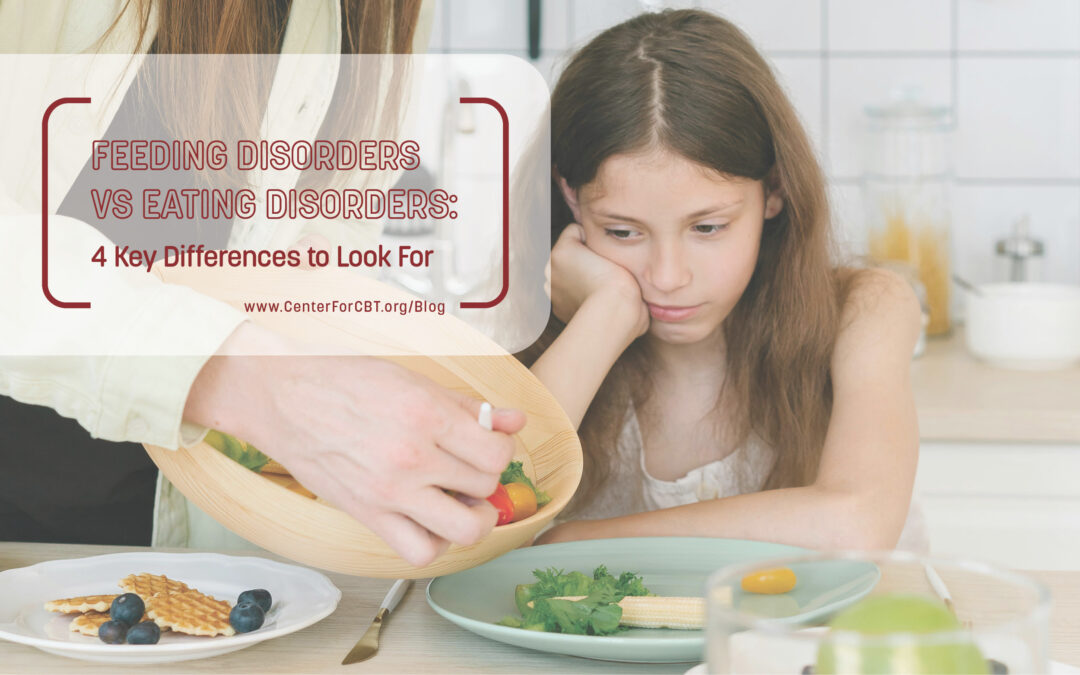When a child struggles to maintain a consistent or balanced diet, it can be difficult for parents to determine whether the issue is simply picky eating or something more serious. A quick online search for “picky eating” often brings up articles about both feeding disorders and eating disorders—terms that are frequently used interchangeably but refer to distinct clinical diagnoses. Understanding the differences between feeding and eating disorders is an important first step in identifying the right course of treatment for your child.
Understanding Feeding Disorders
Feeding disorders are defined as persistent disturbances in eating or eating-related behaviors that result in significant nutritional, physical, or psychosocial impairments (American Psychological Association, 2022). These disorders are typically not driven by concerns about body weight or shape. Instead, the challenges often involve issues such as extreme food selectivity or sensory sensitivities. They may also result in challenging behaviors around mealtimes.
One of the most commonly diagnosed feeding disorders is avoidant/restrictive food intake disorder (ARFID). ARFID is more than just picky eating—it is characterized by restrictive eating patterns that prevent a child from meeting their nutritional or caloric needs. This disorder can present in a variety of ways, such as:
- Avoiding entire food groups or new foods
- Consuming only a limited variety of foods (e.g., only one or two foods per group)
- Refusing foods based on texture, color, temperature, or brand
- Gagging or vomiting during meals
- Emotional outbursts or tantrums at mealtimes
- Failure to gain or maintain weight
- Dependency on nutritional supplements or feeding tubes
- Strong sensory aversions or sensitivities
ARFID typically develops in infancy or early childhood but can persist into adolescence and adulthood if not addressed. The impact of ARFID goes beyond nutritional deficits. It often causes significant disruption to family dynamics and social interactions, especially around mealtimes, eating out, or attending events like birthday parties.
Other notable feeding disorders include pica and rumination disorder. Pica involves the consumption of non-nutritive, non-food substances such as dirt, clay, hair, or paper, and is considered developmentally inappropriate beyond the toddler years. Rumination disorder involves the regurgitation of previously swallowed food, which may then be re-chewed, spit out, or swallowed again. Importantly, this behavior is not due to a medical condition and is often described as involuntary.
Understanding Eating Disorders
While the terms may sound similar, eating disorders are distinct from feeding disorders in several key ways. Eating disorders are typically marked by significant concerns regarding body image, weight, and self-perception, as well as behaviors aimed at controlling or altering one’s weight (American Psychological Association, 2022). These conditions are often accompanied by emotional distress, including feelings of shame, embarrassment, or guilt related to food and eating. Common eating disorders include:
- Anorexia nervosa: restrictive eating, intense fear of weight gain, and distorted body image. Individuals may engage in compensatory behaviors such as excessive exercise, purging, or misuse of diet pills.
- Bulimia nervosa: episodes of binge eating followed by compensatory behaviors such as vomiting, fasting, or excessive exercise. Like anorexia, it is driven by negative body image and fear of weight gain.
- Binge eating disorder: recurrent episodes of eating large quantities of food, often rapidly and to the point of discomfort. These episodes are typically followed by distress, guilt, or shame but are not accompanied by compensatory behaviors.
Unlike feeding disorders, eating disorders most commonly emerge during adolescence or early adulthood and are more frequently associated with sociocultural influences, perfectionism, and emotional regulation difficulties.
Key Differences Between Feeding and Eating Disorders
Differentiating between feeding and eating disorders can be challenging, especially because both can involve limited food intake, nutritional deficiencies, and social disruptions. However, several core distinctions can help clarify the diagnosis:
- Motivation: Feeding disorders are not driven by concerns about weight or body image, while eating disorders are characterized by body dissatisfaction and a fear of weight gain.
- Age of Onset: Feeding disorders often appear in infancy or early childhood, whereas eating disorders typically emerge in adolescence or early adulthood.
- Behavioral Features: Feeding disorders may include strong aversion to certain sensory aspects of foods and challenging behavior at mealtimes (e.g. tantrums, screaming, throwing food, refusal to sit at the table). Eating disorders often limit food intake based on caloric density and compensatory behaviors, like purging or excessive exercise.
- Emotional Component: Individuals with feeding disorders may show anxiety about eating, but not shame or embarrassment about body size. Those with eating disorders usually experience intense emotional responses tied to food and body image.
Treatment Options for Feeding and Eating Disorders
Accurate diagnosis is essential for determining the most effective treatment plan. Both feeding and eating disorders benefit from early intervention and evidence-based care tailored to the individual’s specific symptoms, history, and needs.
Treatment for Feeding Disorders
Treatment for feeding disorders typically begins with a comprehensive assessment of the child’s dietary habits, eating behavior, sensory preferences, and medical history. A meal observation is often included to assess interactions and challenges in real-time. Interventions may include:
- Creating structured mealtimes and routines
- Teaching parents behavioral strategies to reduce conflict and reinforce positive eating behaviors
- Using exposure therapy and reward systems to expand food preferences
- Implementing coping tools to address anxiety or aversions related to specific foods
- Collaborating with pediatricians or dietitians for medical management
The goal is to increase nutritional intake, broaden food variety, and reduce stress for both the child and their family.
Treatment for Eating Disorders
Eating disorders require a multidisciplinary approach involving mental health professionals, dietitians, and, in some cases, medical doctors. Treatment may include:
- Cognitive-behavioral therapy (CBT) to address negative thought patterns and beliefs around food and body image
- Family-based therapy, particularly for adolescents
- Nutritional counseling to ensure proper caloric intake and support weight restoration
Monitoring and management of co-occurring conditions such as anxiety or depression - Education and skills training around emotional regulation and self-esteem
While recovery is possible, eating disorders often require long-term treatment and support to prevent relapse and promote lasting behavioral change.
When to Seek Help

At the Center for CBT, we have psychologists on our team who specialize in the evaluation and treatment of feeding disorders. . We offer compassionate, evidence-based care for children and adolescents who are struggling with feeding-related challenges—and support for the families who care for them.
If you’re concerned about your child’s eating habits or behavior, we’re here to help. Contact us to learn more about how we may be able to support the needs of your child and your family.




